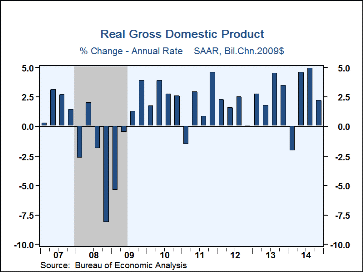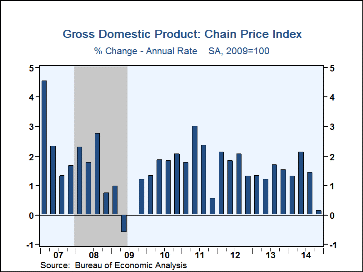 Global| Mar 27 2015
Global| Mar 27 2015U.S. GDP Growth is Unchanged at 2.2%; Corporate Profits Decline
by:Tom Moeller
|in:Economy in Brief
Summary
Real GDP growth of 2.2% during Q4 2014 was unrevised in the latest estimate (2.4% y/y). The increase compared to an expected 2.4% rise in the Action Economics Forecast Survey. During all of last year, real GDP expanded 2.4%, up from [...]
Real GDP growth of 2.2% during Q4 2014 was unrevised in the latest estimate (2.4% y/y). The increase compared to an expected 2.4% rise in the Action Economics Forecast Survey. During all of last year, real GDP expanded 2.4%, up from 2.2% and 2.3% during the prior two years.
After-tax corporate profits fell at an 11.5% rate (+2.9% y/y), reversing the Q3 rise. Nonfinancial sector profits gained 5.7% (7.8% y/y), far weaker than during the prior two quarters. Financial sector earnings declined 10.3% (-9.8% y/y) while earnings from abroad fell at a 30.8% rate (-11 .6% y/y), the third decline in four quarters.
A minimal degree of inventory decumulation was revised from slight accumulation estimated last month. Both figures are lower than the 0.8 percentage point addition figured initially. Deterioration in the foreign trade deficit subtracted a lessened 1.0 percentage points from economic growth, the same as figured in the initial estimate. Exports grew at a 4.5% rate (2.4% y/y) compared to 3.2% figured last month while imports jumped at a 10.4% rate (5.6% y/y) compared to last month's estimate of 10.1%.
Growth in domestic final sales was inched up to 3.3% (2.9% y/y). Business fixed investment growth of 4.7% (6.2 y/y) was little-changed. Investment in information processing equipment grew 19.9% (6.9% y/y) but industrial equipment fell 15.5% (+11.8% y/y). Investment in intellectual property products increased 10.3% (7.3% y/y). Business investment accounted for 0.6 percentage points of GDP's increase last quarter.
The increase in consumer spending was bumped up to 4.4% (2.9% y/y) and added 3.0 percentage points to GDP growth. Services spending grew 4.3% (2.2% y/y), the largest rise since Q2 2000. Health care spending increased 7.9% (3.7% y/y), food services outlays grew 7.0% (3.9% y/y) and recreation spending rose 3.6% (0.1% y/y). Spending on durable goods grew 6.2% (8.1% y/y) led by a 9.4% rise (10.4% y/y) in recreational goods & vehicles. Purchases of furniture grew 6.8% (6.5% y/y) while motor vehicles gained 3.8% (9.8% y/y). Nondurable goods spending rose 4.1% (2.2% y/y), paced by a 9.5% jump (3.0% y/y) in apparel. Purchases at restaurants slipped 0.3% (-0.7% y/y), down for the fourth straight quarter. Lower prices spurred a 9.1% jump (2.1% y/y) in real gasoline & fuel oil usage, off 31.6% (-9.2% y/y) in nominal dollars.
Residential investment spending growth was increased 3.8% (2.5% y/y), up slightly from Q3. A 1.9% decline (+0.8% y/y) in government spending was little-changed. National defense spending fell 12.2% (-0.3% y/y).
The GDP chain price index edged 0.1% higher (1.2% y/y), unchanged from last month's estimate. The personal consumption price index fell 0.4% (+1.1% y/y) but it rose 1.1% (1.4% y/y) excluding food & energy. The business fixed investment price index gained 0.3% (1.0% y/y), held back by a 1.7% decline (+0.3% y/y) in intellectual property product prices. The residential investment price index gained 4.5% (5.2% y/y).
The latest GDP figures can be found in Haver's USECON and USNA databases; USNA contains basically all of the Bureau of Economic Analysis' detail in the national accounts, including the integrated economic accounts and the recently added GDP data for U.S. Territories. The Action Economics consensus estimates can be found in AS1REPNA.
| Chained 2009 $, %, AR | Q4'14 (Third Estimate) | Q4'14 (Second Estimate) | Q4'14 (Advance Estimate) | Q3'14 | Q2'14 | Q4 Y/Y | 2014 | 2013 | 2012 |
|---|---|---|---|---|---|---|---|---|---|
| Gross Domestic Product | 2.2 | 2.2 | 2.6 | 5.0 | 4.6 | 2.4 | 2.4 | 2.2 | 2.3 |
| Inventory Effect | -0.1 | 0.1 | 0.8 | -0.0 | 1.4 | 0.0 | 0.1 | 0.0 | 0.1 |
| Final Sales | 2.3 | 2.1 | 1.8 | 5.0 | 3.2 | 2.4 | 2.3 | 2.2 | 2.2 |
| Foreign Trade Effect | -1.0 | -1.2 | -1.0 | 0.8 | -0.3 | -0.5 | -0.1 | 0.3 | 0.1 |
| Domestic Final Sales | 3.3 | 3.2 | 2.8 | 4.1 | 3.4 | 2.9 | 2.4 | 1.9 | 2.1 |
| Demand Components | |||||||||
| Personal Consumption Expenditures | 4.4 | 4.2 | 4.3 | 3.2 | 2.5 | 2.9 | 2.5 | 2.4 | 1.8 |
| Business Fixed Investment | 4.7 | 4.8 | 1.9 | 8.9 | 9.7 | 6.2 | 6.3 | 3.0 | 7.2 |
| Residential Investment | 3.8 | 3.3 | 4.1 | 3.3 | 8.8 | 2.5 | 1.6 | 11.9 | 13.5 |
| Government Spending | -1.9 | -1.8 | -2.2 | 4.4 | 1.7 | 0.8 | -0.2 | -2.0 | -1.4 |
| Chain-Type Price Index | |||||||||
| GDP | 0.1 | 0.1 | -0.0 | 1.4 | 2.1 | 1.2 | 1.5 | 1.5 | 1.8 |
| Personal Consumption Expenditures | -0.4 | -0.4 | -0.5 | 1.2 | 2.3 | 1.1 | 1.3 | 1.2 | 1.8 |
| Less Food/Energy | 1.1 | 1.1 | 1.1 | 1.4 | 2.0 | 1.4 | 1.4 | 1.3 | 1.8 |
Tom Moeller
AuthorMore in Author Profile »Prior to joining Haver Analytics in 2000, Mr. Moeller worked as the Economist at Chancellor Capital Management from 1985 to 1999. There, he developed comprehensive economic forecasts and interpreted economic data for equity and fixed income portfolio managers. Also at Chancellor, Mr. Moeller worked as an equity analyst and was responsible for researching and rating companies in the economically sensitive automobile and housing industries for investment in Chancellor’s equity portfolio. Prior to joining Chancellor, Mr. Moeller was an Economist at Citibank from 1979 to 1984. He also analyzed pricing behavior in the metals industry for the Council on Wage and Price Stability in Washington, D.C. In 1999, Mr. Moeller received the award for most accurate forecast from the Forecasters' Club of New York. From 1990 to 1992 he was President of the New York Association for Business Economists. Mr. Moeller earned an M.B.A. in Finance from Fordham University, where he graduated in 1987. He holds a Bachelor of Arts in Economics from George Washington University.












